By Jeffrey A. Rendall, Photos by Chuck Rendall
KAPALUA, MAUI, HI – “The term Kapalua means ‘arms embracing the sea’….that can been seen from aerial photos with the rock outcroppings resembling two arms reaching out to hug the sea,” remarked Kapalua Director of Golf Mike Jones, in describing the story behind the famous resort’s name.
Because of the PGA Tour season opening Hyundai Tournament of Champions, most people probably think of the world famous Plantation Course when talking about Kapalua. But according to Jones, it’s the Arnold Palmer/Francis Duane-designed Bay Course that is known as Hawaii’s favorite resort course.
With a healthy complement of resort courses in the Aloha State, the “favorite” may be a matter of opinion, but there’s little doubt that the Bay Course is something special – and would garner a good many votes. Placed alongside the deep blue sea on Maui’s western shore, the course even touches the ocean for two holes – not even the Plantation Course can make that claim.
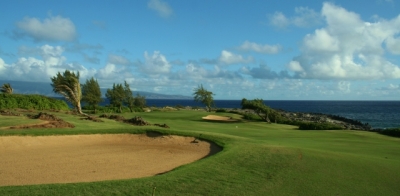 |
| The dogleg left par four 4th hole is not particularly long or difficult -- but it is definitely one you will remember. |
And the par three 5th is the only hole on Maui that requires you to shoot over a sliver of the ocean, not exactly an experience that you’re going to get everywhere. The sound of waves crashing on the rocks is a bit distracting – in the good sense – but this is probably what you’ll remember most about your trip to the Bay Course.
One thing’s for sure: there isn’t a more beautiful setting for a golf course anywhere. The island of Molokai resides just to the west, close enough so that you almost think you can swim (or at least it looks that way). During the winter months, Humpback whales can often be seen breeching from shore.
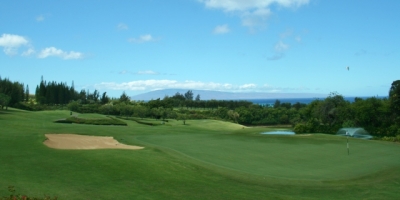 |
| Looking from behind the par three 17th hole. |
Kapalua’s a playground for more than humans, apparently.
Originally opening in 1975 (and hosting the PGA Tour’s Kapalua International tournament until the mid-90’s, and also attracted the LPGA), the Bay Course acquired a reputation for being a short but still challenging layout. According to his golf design partner, Bill Coore, the fact that Ben Crenshaw liked the area so much (when playing in the tournament) contributed heavily to their decision to design the Plantation Course.
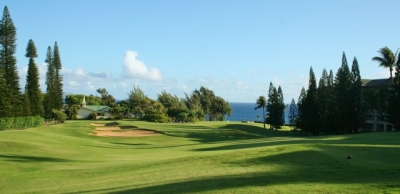 |
| Moving towards the ocean, the par three 3rd hole often includes a viewing "gallery" from the Ritz-Carlton Hotel along the right side. |
In other words, the “atmosphere” is already built in at Kapalua.
Recent upgrades to the course have only made it better, though the layout itself was left basically intact. “All 18 greens were updated with a TifEagle Bermuda surface and reshaped for larger green surfaces,” Jones explained. Other improvements included laser-leveling the tee boxes, redoing the bunkers, enlarging the practice putting green and installing a short-game practice area.
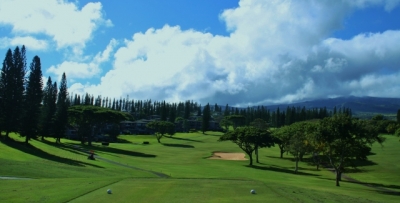 |
| The view from the tee of the par five 10th hole reveals how there is plenty of room on the Bay Course, yet you just cannot hit it anywhere to score well. |
The resort put $3 million into the renovations, which also included instituting new maintenance practices to ensure top notch playing conditions. Needless to say, the additional emphasis on quality surfaces have paid off for the players – you won’t find better conditions anywhere in Hawaii.
The routing takes the course through a residential area (and the par three 3rd hole is next to the Ritz Carlton Hotel), though the extremely wide corridors still preserve an ‘open’ feel to the Bay Course. Like every destination that caters heavily to resort players, the Bay will allow you to spray the ball around and not lose many balls – why add frustration when you’re on vacation?
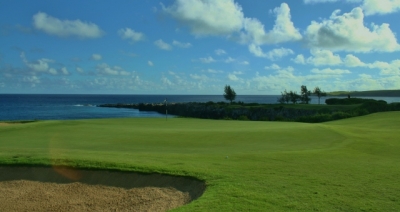 |
| From behind the green of the signature par three 5th hole. The view does not require a description. |
As noted earlier, the Bay is hardly a pushover, however. “Wind is always a factor in Hawaii, and the new green surfaces are fair, but more challenging than in the past,” Jones said in describing the Bay’s more difficult aspects. “To play well, you have to put the ball in the fairway and have a good short game,” he added.
Just because there’s a lot of room to “miss” doesn’t mean you can always get away with it, in other words. The course allows for run-up shots on nearly all the greens (hence, the reward for being in the fairway), but if you’re in the rough, chances are you’re going to have to fly a bunker to reach the putting surface. And while the bunkers aren’t “deep” by modern construction standards, they’ll provide enough of a test for resort players who don’t practice their sand shots much.
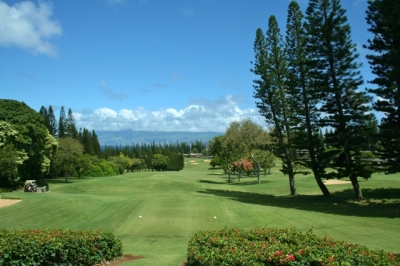 |
| It may appear narrow off the tee of the par five 18th hole, but there is plenty of room waiting in the landing area. |
As Jones mentioned, the greens are tricky, too. A good example is the par four ninth, where if you miss above the hole, you could very well putt the ball off the green (we know, because it happened). The dreaded Bermuda grass grain is going away from you on that green, making all downhill putts especially slick.
But Bermuda grass greens can also help your putting, in one sense. We received a tip from a local on how to read them. In addition to noting the different colors in the grass (shiny means with the grain (fast), and darker green means against it (slow)), the cup will have a brown side to it – which will always be the downhill side. So even if the putt may look uphill, you’ll always know which way the green slopes.
 |
| The Pacific is the backdrop to the par four 9th hole -- but keep your focus on the short-iron approach shot. Going long is bad news on this hole. |
We tested the theory on more than one occasion, and it works. Try it for yourself.
On the “easier” side, the Bay Course offers four sets of tees, so all levels of players can enjoy it (ranging from 5124-yards to 6600-yards). In addition, there are only a few forced carries off those tees (most notably the shot over the ocean on the 5th hole), so you won’t have to worry much about the dreaded occasional short low-liner when your driver doesn’t cooperate.
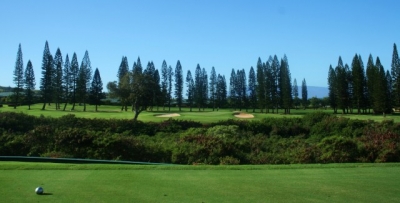 |
| The par three 12th hole requires a bit of a carry to reach safety, but it should not be a problem for most players. |
Jones pointed out one other “friendly” aspect: “Pace of play at the Bay Course averages right at four hours.” In Hawaii, that’s not something to overlook – as you won’t want to miss out on all that Maui has to offer.
Picking highlight holes is especially tough on the Bay Course – they’re all good -- but certainly the 5th hole (as described above) will make everyone’s list. The hole does stretch to 205 yards from the back tees, and it’s practically all carry – so better take note of the wind direction that day if you’re playing the tips.
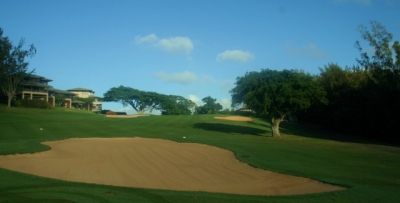 |
| This large bunker guards the dogleg on the par four 7th hole, and it likely gets frequent visits. |
The par four ninth is the one alluded to above with the tricky green, but it’s also noteworthy for the beautiful ocean view you’ll encounter from tee to green. The second shot is downhill, so it almost looks like you’re hitting into the ocean – quite a backdrop.
On the back nine, Jones thinks the par five 15th is a great hole. “A lot of people like it because it gives you a solid chance at birdie. Ranging from 412 to 539-yards, it plays shorter than the distance but has a challenging green you have to conquer to get that birdie – or maybe even an eagle.” He’s right – if you’re above the hole, it’s another scenario where you’re going to have a hard time stopping your putt on the short grass.
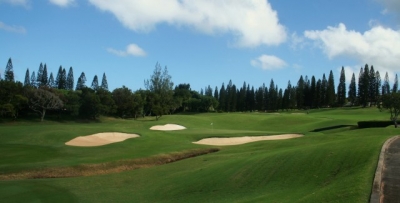 |
| The par four 16th hole plays uphill and often into the wind. No wonder it is rated the #2 handicap hole. |
The par four 16th hole is probably the hardest hole on the Bay Course if the wind is blowing hard. It’s only 371-yards in length, but it’s all uphill, and there’s a hazard that splits the fairway. If the trade winds are blowing, look out.
Finally, you’ll definitely remember the closing par five 18th hole. The drive is downhill (and with the wind), so you can air-it-out, but the green is very well bunkered. Going for it in two can be risky. It can also be rewarding: “Morgan Pressel made a putt from off the green to win the 2008 Kapalua LPGA Classic,” Jones remembered.
One additional note is the service that Kapalua resort offers – at both the Plantation and Bay Courses. It’s fair to say that you’ll get reasonably good service at all the higher-end resorts in Hawaii, but as a Troon Golf facility, the service is exceptional at this one. Even the rental clubs were noteworthy, as the driver in the bag was a Titleist 910 D3 – which gave us a chance to try out for 18 holes one of the best clubs out there.
Of course, no trip to Kapalua should be without a visit to the Plantation Course – and it’s very possible to play both the Plantation and the Bay on the same day (if you’ve got the stamina, and the budget). But it would be a mistake to think that Kapalua golf is only about the more “famous” hillside course that you see on TV every January.
It’s worth a trip around the Bay Course, too – it’s not just the “other” layout at Kapalua.
Details:
Kapalua Bay Course
300 Kapalua Drive
Lahaina, Maui, HI 96761
Phone: 1-877-KAPALUA
Website: www.golfatkapalua.com
General Manager: Mike Jones, PGA
Head Professional: Doug Bohn, PGA
Director of Agronomy: David Smallwood
Superintendent: Bill Lucena
Course Designers: Arnold Palmer & Francis Duane
Tees/Yardage/Slope/Rating
Championship: 6600 136/72.1
Regular: 6051 129/69.0
Resort: 5676 124/68.3
Forward: 5124 121/69.6
Note: Carts Mandatory
Rates/Packages:
$208 standard rate, $183 if staying on resort
$138 after 1 pm.
Packages through the Ritz Carlton Kapalua and the Kapalua Villas (a one price stay and play package that includes unlimited golf on a daily basis from April 1st to December 19th each year.
| Related Links | Comments on this article? | |
|
Maryland National Golf Club Hollow Creek Golf Club Rocky Gap Resort PB Dye Golf Club in Ijamsville Whiskey Creek Golf Club |
E-mail Jeff Rendall, Editor: jrendall@golftheunitedstates.com |











